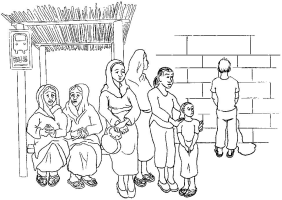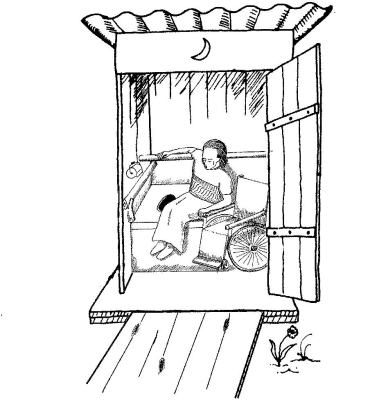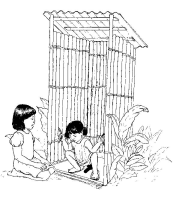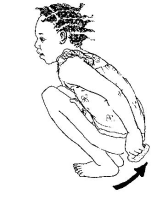Introduction
Every person and every community has a way of dealing with sanitation, even if it just means that people go into the bush to urinate and defecate. Households and communities can benefit from talking about the sanitation methods that will work best for everyone. Healthy sanitation must consider the needs of children, who cannot take care of themselves. It must also ensure that women have toilets that they feel safe using and a way to keep clean during monthly bleeding.
Small steps to sustainable sanitation
In any community - and even in a single household - there may be several sanitation methods in use at one time. Some people may want to change the way they take care of their sanitation needs, while others may not. Whether it means building a new kind of toilet, helping to meet the needs of those without access to safe toilets, or some other kind of change, almost every sanitation method can be improved.
Small, step-by-step changes are easier than big changes all at once. Examples of small changes that can have a big impact on health, safety, and comfort are:
- keeping wash water and soap near the toilet
- adding a vent to a pit toilet
- adding a hard, durable platform to an open pit
When planning or making changes in household or community sanitation, keep in mind that every sanitation method should do these things:
- Prevent disease - it should keep disease-carrying waste and insects away from people, both at the site of the toilet and in nearby homes.
- Protect water supplies - it should not pollute drinking water, surface water, or groundwater.
- Protect the environment - ecological sanitation can prevent pollution, return nutrients to the soil, and conserve water.
- Be simple and affordable - it should fit local people's needs and abilities, and be easy to clean and maintain.
- Be culturally acceptable - it should fit local customs, beliefs, and desires.
- Work for everyone - it should address the health needs of children and adults, of women and men.
Sanitation decisions are community decisions
Because people have different sanitation needs, decisions about sanitation should be made by the people who will be most affected by those decisions. And because household and neighborhood sanitation decisions can affect people downstream, communities need to work together to improve sanitation for all.
Community participation can make the difference between success and failure when a government or outside agency plans a sanitation program. When local people participate in sanitation planning, the result is more likely to fit local needs.
In 1992, the government of El Salvador spent over 10 million dollars to build thousands of new toilets. The new toilets were different from the kind that local people were used to, and needed more care and cleaning than normal toilets. There was no training in how to use them, and the government did not invite communities to help make them.
After the project was done, the government did a study to find out how the toilets were being used. They learned that a large number of the toilets were not being used well, and many were not used at all.
Someone must clean the toilet
People have different ideas about who should clean toilets. Even in a single household, this can be a difficult problem to resolve in a way that satisfies everyone.
Often, the job of planning, building, and fixing toilets is considered men's work or work for specialists. But the less pleasant and more constant task of cleaning toilets often falls to women or people of lower social classes. If tasks that are necessary but unpleasant always fall to people with no voice in making decisions, it is unfair. And in the long run, it can lead to these tasks being done poorly, or not being done at all.
Sharing unpleasant tasks is a way to ensure that the work gets done.
Women and men have different sanitation needs
Women and men have different needs and customs when it comes to sanitation. Men may be more comfortable than women relieving themselves in public or open spaces. Women are burdened with a greater share of family work like collecting water and firewood, cooking, and cleaning. They are usually responsible for taking care of children and their sanitation needs as well. All of these things affect their access to toilets that are safe, clean, comfortable, and private.
Addressing women's needs often challenges traditional ideas about how decisions are made. Because it may be difficult to make or accept changes, it takes time and effort by both men and women to improve health for everyone.
 |
| Women and men have different needs and customs when it comes to sanitation |
|
© The Hesparian Sanitation
|
Sanitation planning with women's needs in mind
While women have needs for safe and healthy sanitation, they may not have the money, resources, power, or confidence to ensure that their needs are met. Leaving women out of sanitation planning puts them at a greater risk of health problems. This increases their burden even more.
Men must provide incentives for women to participate in community sanitation in a way that does not simply give them more work to do, especially the most unpleasant tasks. This requires:
- organizing meetings at times when women can participate.
- ensuring that women are invited to speak out and can feel comfortable speaking out.
- having separate meetings for women if it makes open discussion easier.
- sharing decision-making power.
Women usually teach and care for children. When women's needs are not met, the needs of future generations may be unmet as well. When women are not included in planning household and community sanitation, the whole community suffers.
Removing the Barriers to Sanitation for Women
This activity helps people to talk about issues that may prevent women from having access to safe and healthy sanitation. The goal is to decide what changes might be necessary to improve health for everyone. After the activity has been done with just women, a session can be organized with both men and women.
Time: 1 to 1 ½ hours
Materials: flip chart or large drawing paper, pens, sticky tape.
Step 1. Write statements about sanitation on a flipchart or large piece of paper. Then read each statement to the group, and ask each person to decide whether she agrees or disagrees. (Ask people to raise a hand if they agree, or to make no motion if they do not.) For every "yes" answer, make a mark next to the phrase. For every "no" answer, make no mark. Here are some statements that might be used.
Step 2. Count the marks beside each statement. Choose the problems that were mentioned most and begin a discussion about them. What is the cause of the problem? What illnesses may result from this problem? What can be done to improve the situation? What are the barriers to improving the situation?
Step 3. End with the group deciding on some specific actions that can be taken by both men and women to ensure that everyone's needs are met.
Access for disabled children and adults
There are many ways to make toilets easier for disabled children and adults to use. Involve disabled people in planning and be creative in finding solutions that fit their needs.
People need different adaptations depending on their ability
If a person has difficulty squatting, make a simple hand support or a raised seat.
If a person has difficulty controlling her body, make supports for her back, sides, and legs, and a seat belt or bar.
Use a rope or fence to guide blind people from the house to the toilet. If a person has difficulty pulling down pants, adapt her clothing to make it loose or elastic. Make a clean, dry place to lie down and dress. If a person has difficulty sitting you can make moveable handrails and steps.
 |
| Raised seat for people with difficulty to squat. A removable front bar can be added if needed. |
|
© The Hesparian Sanitation
|
Toilets for wheelchairs:
 |
| Toilets for wheelchairs |
|
© The Hesparian Sanitation
|
- shelter big enough so that a wheelchair can fit inside
- arm or shoulder supports close to the toilet
- toilet seat and wheelchair on same level
- extra wide door for easy access
- hand rail to make moving from wheelchair to toilet easier
- wheelchair can enter beside the toilets without having to turn around
- ramp to allow wheels to roll in
- path to the toilet is level and easy to get to from the house
- Remember, a disabled person feels the same need for privacy as anyone else. Help disabled people get the privacy they need.
Sanitation for children's health
|
Children have a high risk of illness from poor sanitation. While adults may live with diarrhea diseases and worms, children die from these illnesses.
It is important for children to have toilets that are safe and that feel safe. When children feel safe using the toilet and have an easy way to stay clean, they get sick less. Pit toilets can be dangerous and frightening for small children because of the darkness and the large hole. Many children, especially girls, leave school because safe toilets and healthy conditions are not provided for them.
Allowing children to help build toilets and teaching them about illness caused by poor sanitation are some ways to help them develop healthy behaviors.
|
| |
| |
 |
| Sanitation for children's health |
|
© The Hesparian Sanitation
|
 |
|
Every school should have safe sanitation and a way for children to wash hands after using the toilet.
|
|
© The Hesparian Sanitation
|
Helping small children stay clean
Many people believe that children's feces are not as dangerous as those of adults. This is not true. All feces carry many harmful germs, and handling them can cause serious illness in children
and adults.
In rural areas, parents can help children too small to use a toilet by making a hole near the house, and covering the hole after each use. It is also important to:
- Wash babies and young children after they defecate.
- Wash hands after handling babies' feces.
- Bury the feces or put them in a safe toilet.
- Wash soiled clothes away from drinking water sources.
Teach boys and girls to wipe or wash carefully and to wash their hands after using the toilet. Girls especially should be taught to wipe from front to back. Wiping forward can spread germs into the urinary opening and the vagina, causing bladder infection and other health problems.
 |
| Helping small children stay to clean |
|
© The Hesparian Sanitation
|
Sanitation for cities and towns
In cities and towns that lack sufficient water and sanitation, serious health problems can spread very quickly. But because of the crowded and built-up nature of cities, it is difficult to improve sanitation services without a lot of help from local or national governments, NGO's, and other international development partners. This book can only offer some guidelines to help think about possible solutions.
The main barriers to good sanitation services in cities are:
- Political. Local governments may not want to deliver services to informal settlements and poorer neighborhoods. And there may be laws that prevent people from planning and building their own sanitation systems.
- Cultural. People and officials in cities often want flush toilets and costly sewer systems, making it difficult to agree on more sustainable and affordable alternatives.
- Physical. Often, sanitation is considered only after neighborhoods and settlements have roads, electricity, and water. Once a city is built, it is much harder to plan for and build sanitation services.
- Economic. Large sanitation systems, especially water-based systems, are costly to build and maintain. If water systems are privately owned rather than provided by governments, it is even harder for people to afford sanitation.
Planning for urban sanitation is made easier when:
- people have choices that fit their different needs.
- community groups take the lead in developing solutions that are appropriate and affordable.
- people's human right to have water is recognized.
- the needs of the most vulnerable groups are taken into account.
- partnerships are built among communities, non-governmental organizations, local governments, and businesses. For these partnerships to work well, they must be controlled by those most in need of sanitation improvements - the communities themselves.
Sanitation for emergencies
In emergency settlements such as refugee camps, sanitation is a first priority. Simple defecation trenches and pit toilets can be made quickly using local materials. One trench or pit toilet for each family, or for a small group of families, will allow for the most comfortable use.
Sanitation trenches and pit toilets should be built downhill and away from water sources, but close enough to family settlements that people do not have to walk long distances to use them. This shallow trench latrine is easier to dig than a pit toilet or a deep trench. It has shelves for the feet to make it easier to use than a simple trench. The trench is about 30 centimeters deep. Each user covers his or her feces with a small amount of soil. A portable shelter can be built to give privacy and to protect users from rain. Special care should be taken to assure women's privacy and safety.
When it is full, cover the trench completely with soil. Plants and trees will benefit from the rich soil.
 |
| Sanitation for emergencies |
|
© The Hesparian Sanitation
|
Community sanitation in Yoff, Senegal
Not long ago, Yoff was a typical West African fishing village outside of Dakar, the capital city of Senegal. Families lived in compounds connected by walking paths and open spaces. But as Dakar grew and swallowed Yoff, it became part of a large urban area with an international airport and a lot of car traffic.
As the town grew, many houses installed flush toilets connected to tanks to collect the sewage. When the tanks filled up, people pumped them out into open pits where the sewage sat and bred disease. Other people who were too poor to afford toilets used open sandy areas to fulfill their needs. But with many people living close together, this quickly became a health problem. A town development committee came together to solve these problems. They began by looking at the resources they had: strong community networks, skilled builders, and people committed to keeping village life. They also had some new ideas about ecological sanitation.
In the village, houses were grouped around open common areas where people could gather and talk. After talking to many villagers, the committee made a plan to use this open area for a sanitation system that would make the area more attractive, rather than uglier. Instead of promoting household toilets and underground sewage tanks, they would promote community ecological sanitation. The committee worked with residents to build urine-diverting dry toilets. Each set of toilets would be shared by the whole compound. The urine would run through pipes into beds of reeds.
The feces, after being dried out, would be used to fertilize trees. All of this would help to keep the village green. Local masons and builders were hired to construct the toilets and to maintain the common areas. This urban sanitation project not only prevented health problems - it helped to preserve the way the people of Yoff wanted to live.
Creative solutions for healthier cities
Urban sanitation does not have to use large water-based systems. In fact, in most of the world, large water-based systems cause more problems than they solve. Water-based sanitation systems produce large amounts of dirty water that must be treated before it can be reused. If it is not purified - and it usually is not ? this leads to serious environmental and health problems.
If urban sanitation services are combined with urban farming, parks, garbage collection, and energy production, cities can become healthier and more beautiful places to live. When community groups work with local governments to come up with creative solutions, the result will be greener, healthier cities.
Information Source Links
- Sanitation and Cleanliness for a Healthy Environment - The Hesperian Foundation in collaboration with the United Nations Development Programme (2005). The Hesperian Foundation







